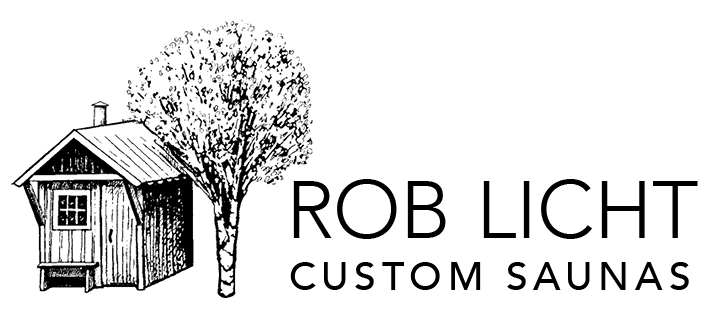
The old Sauna at Podunk had two rooms: a small dressing room and the larger hot room. The Old Nippa stove sat between them embedded in a masonry wall. Sitting on the benches we stared at the business end of the stove with its pile of rocks and the stove was tended from the dressing room.
This arrangement always made sense to me and is how I have been building my saunas for 30 years. I learned to weld in art school and set up my own studio soon after. Ozzie would send people my way for their stove repairs. After seeing how other stoves failed, I designed and started making my own stoves using much heavier plate on the top, where the heat would soften the thinner steel and typically lead to collapse under the weight of the rocks. I also kept to the external feed (thru-wall) and designed my stoves to be fired exclusively that way. As kids, we loved to pretend we could speak Finnish by stretching vowels and consonants together and making up Finnish sounding nicknames for each other. I called my stove the Lämpimämpi by combining Lemp and Memp. Finns will chuckle at this because it translates to: “warmer”.
I called my stove the Lämpimämpi by combining Lemp and Memp.
Finns will chuckle at this because it translates to: “warmer”.



There are so many reasons for the external feed (thru-wall):
• The fire-tending, and ash debris are kept out of the hot room and you don’t have to tramp in and out with your boots on to tend the fire.
• Venting a small space can be complicated; a sauna stove requires significant combustion air which can create drafts or, worse, rob oxygen from the hot room. The external feed draws air from the dressing room or outside.
• Any stove front requires 36 inches of clearance to combustibles in front of it. This can’t be mitigated by heat shields. This severely limits the layout of the hot room. However, it is easy to get 3 feet in front of the stove in the dressing room.
• Any stove also requires a noncombustible hearth (stone) 18” in front of the stove. Hot ash and coals falling out the stove are a major source of fires. In a crowded and dark sauna room these hot coals can easily be overlooked, fall under duck boards, etc.
•A flickering flame to look at may be romantic but it is the soft heat off the rocks you want, not the searing radiant heat you get from sitting in front of a blazing fire. Typically, the fire may be almost out by the time the sauna is ready. The rocks should be the focal point. Also, following the 36-inch rule above, you can’t have the stove front facing the bathers, unless the sauna is excessively big.
• If you are providing a sauna experience for others, you can discreetly tend the fire without interrupting the bathers or invading their privacy.
•The external feed stove or thru-wall heats the dressing room just enough so that you can hang out and watch the fire while the sauna heats up.


Installing the external feed may seem daunting but it is not that difficult. A firewall with the requisite size opening will be required. This can be solid masonry, which will add thermal mass (and take longer to heat the sauna) or a hollow insulated firewall with steel studs and cement board, and tile or stone facing, or stucco over metal lathe (which I typically use). A metal sleeve will be provided with the stove to dress up this opening and provide further heat shielding. My Lämpimämpi stove has an integrated heat shield / rock basket that works with the wall opening so that fresh air coming in is heated directly by the stove and directed over the rocks, which is an advantage over simply having the rocks sit on top inside a steel box. As with any installation, all listed clearances need to be adhered to, but with this method, the stove will take up less space in the hot room and make for a cleaner presentation. For your next sauna, consider this traditional way of building it.




